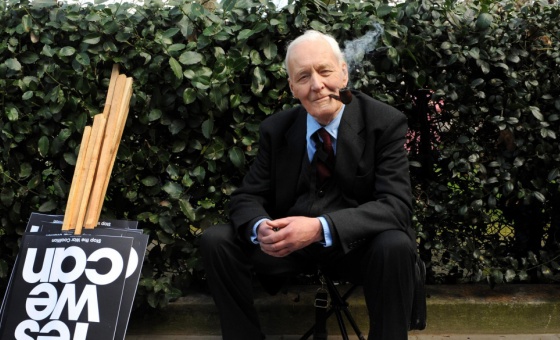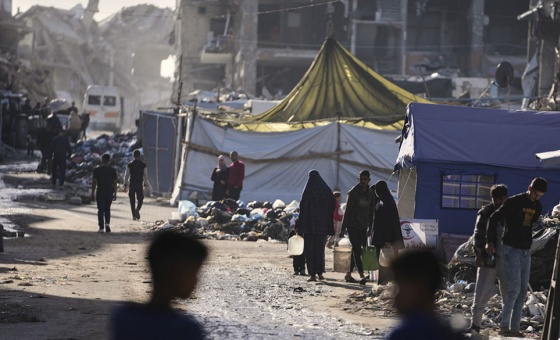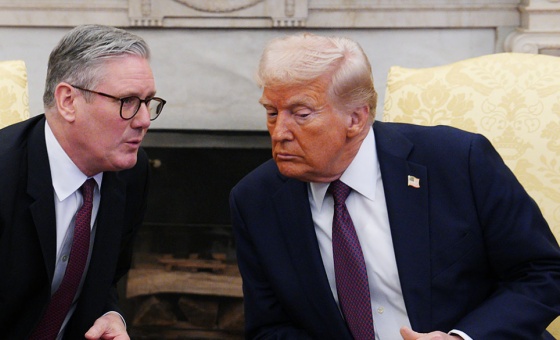This is the last article you can read this month
You can read more article this month
You can read more articles this month
Sorry your limit is up for this month
Reset on:
Please help support the Morning Star by subscribing here
Hamas: The Quest for Power
Beverly Milton-Edwards and Stephen Farrell, Polity Press, £17.99
THIS updated edition of the authors’ original 2010 work on Hamas explores the first elected Islamist organisation which has since transformed the Middle East. A chronology at the end goes to January 20 2024, and history remains in motion. It’s a curious sensation to be turning the pages of recent history when one of the main characters, Ismail Haniyeh, is assassinated in real time.
The book is valuable for several reasons. Firstly, it relies on the authors’ interviews with key Hamas and Israeli figures and a broad documentary record. Secondly, it is considered and unemotional, which casts an almost unnerving calmness over a situation that is strewn with exploded bodies on endless social media streams.
Most importantly, it provides a detailed account of Hamas’s development, reasoning and methods, offering a perspective that is completely overshadowed by its mainstream representation as the bogeyman du jour.
Hamas arose primarily as an offshoot of the Muslim Brotherhood. It drew inspiration from Sheik Izz ad-Din al-Qassam, an ascetic prototype Islamist from the 1920s who resisted British colonialism and zionist encroachment. Hamas adopted al-Qassam’s principles of faith, discipline, patience, and armed resistance, naming its military wing after him. Hamas focused on shaping its immediate environment where it couldn’t control external forces.
This approach differed from the dominant Nasser-inspired Arab nationalism of the 1960s and ’70s. Hamas’s founder, Sheik Ahmed Yassin, believed only Islam could lead to liberation and focused on grassroots organisation before becoming a military power.
Hamas opposed Yasser Arafat’s secular Fatah party, particularly rejecting any compromises with Israel, which it deemed illegitimate. Their divergent attitude to the Oslo Accords, negotiated between Bill Clinton, Arafat and Yitzhak Rabin, exemplify the divide between Fatah and Hamas.
Edward Said bluntly called the arrangements “an instrument of surrender, a Palestinian Versailles.” Better deals had been on the table before, and the PLO made unilateral concessions including claims on the land, and conceded even numerous UN resolutions which gave Palestinians refugee rights including compensation and repatriation.
The issue of occupation and the ever-expanding Israeli settlements was kicked into the long grass, and Israel conceded nothing. Rather, Israel took to Hamas as a convenient wedge to split Palestinian forces and Israeli accommodations with Hamas are well documented by the authors.
When the main opposition was seen as the PLO the Israeli military governor of Gaza said that Sheik Yassin’s people presented him with “zero, zero, zero” problems. The accommodations went so far as arranging for Sheik Yassin, who was paralysed, wheelchair-bound and had to be spoon fed his whole adult life, to be assessed in a Tel Aviv hospital to see if Israel’s best surgeons could operate on his spine.
Later, in 2019, reflecting a classic divide and rule doctrine, Binyamin Netanyahu would remark that supporting Hamas was desirable as it maintained separation between the Palestinian Authority in the West Bank and Hamas in Gaza and made a Palestinian state an impossibility. Bezalel Smotrich called Hamas “an asset” and the PA “a burden.”
For a while after Oslo, Arafat was celebrated and became the official partner for peace. Funding was forthcoming and many Palestinians enjoyed a lessening of hostilities for a short time. But an Israeli terrorist assassinated Rabin, atrocities multiplied, and Arafat died. After various iterations of government in Israel the pretence of a “peace process” was abandoned and Israel returned to its maximalist goals.
Hamas continued the resistance where Fatah compromised. Hamas’s immediate aims were clear: “an end to Israel’s occupation of the Palestinian Territories, to violations of Islam’s holy places — especially Al Aqsa — and to the Gaza blockade, and to free all Palestinian prisoners held in Israeli jails.” Only discipline, patience and arms could achieve these aims. Asking nicely would not cut the mustard.
Equally Hamas was pragmatic. It’s difficult to keep up with Hamas’s multitude of animosities and alliances over the years, and equally its arrangements with enemies and partners. At first it despised the secularist left wing organisations as un-Islamic. But in opposing the Oslo accords it later joined with secular Marxist organisations. Overall, it was focused on its aims. It modified its methods according to what worked and what was possible with an immensely weaker hand, and also adjusted its goals, updating its charter in 2017.
The new document dropped its call for Israel’s destruction and agreed to a transitional Palestinian state comprising Gaza, East Jerusalem and the West Bank. It maintained that it would continue to fight the occupation of Palestine, but also that it had no issue with people of the Jewish faith or other religions. It was a practical adjustment towards peace without ceding any rights and was specifically designed to “change the stance of European states.”
Strategically, Hamas has been remarkably effective. Everyone had given up on Gaza by 2023. The Arab world was on the verge of “normalising” with Israel as there was nothing else to do. The besieged, imprisoned and now mostly assassinated descendants of refugees in a tiny enclave have put their cause at the forefront of international politics.
Many have called the methods, if not the aims, of Hamas something that defines it as a terrorist organisation. But, for many, Israel has been unmasked as equally monstrous.
This book is, for the most part, circumspect of emotional language. It doesn’t tell us why the West wants an ally in the Middle East. It doesn’t tell us about zionism, its origins, presumptions and aims. It doesn’t adjudicate on either side’s propaganda claims.
It doesn’t condemn Hamas. It gives us the chance to understand it, which is a necessary, but not sufficient, step for the future of Palestine.











